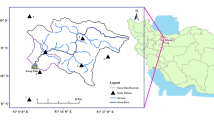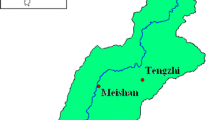Abstract
Predicting runoff is a nonlinear and intricate procedure that is very much important to design canals, managing and arrangement of water usability, controlling flood, and prediction of soil erosion. Many methods to predict runoff on basis of hydro-meteorological and geomorphologic condition is available and being readily used. But recently, a number of soft computing methods have evolved for predicting runoff. The proposed study uses a crossbreed smart model which is an amalgamation of data pre-processing techniques, Genetic Algorithm (GA), and Support Vector Machine (SVM) algorithm for Neural Networks (NN). This manuscript explores the efficiency of SVM evolved NN to forecast rainfall-runoff and usability of this for predicting runoff in Balangir watershed. For an affluent organization of water resources in semi-arid province, predicting one-day lead runoff is very much essential. At a specified instant for predicting runoff, input variables taken into consideration are rainfall and runoff that are witnessed on earlier time period. Genetic operator is cautiously considered for optimizing the NN to avoid untimely meeting and variation problems.
Access this chapter
Tax calculation will be finalised at checkout
Purchases are for personal use only
Similar content being viewed by others
References
Sedki A, Ouazar D, El Mazoudi E (2009) Evolving neural network using real coded genetic algorithm for daily rainfall–runoff forecasting. Expert Syst Appl 36(3):4523–4527
Samantaray S, Sahoo A (2020) Appraisal of runoff through BPNN, RNN, and RBFN in Tentulikhunti Watershed: a case study. In: Satapathy S, Bhateja V, Nguyen B, Nguyen N, Le DN (eds) Frontiers in intelligent computing: theory and applications. Advances in intelligent systems and computing, vol 1014. Springer, Singapore
Samantaray S, Sahoo A (2020) Estimation of runoff through BPNN and SVM in Agalpur Watershed. In: Satapathy S, Bhateja V, Nguyen B, Nguyen N, Le DN (eds) Frontiers in intelligent computing: theory and applications. Advances in intelligent systems and computing, vol 1014. Springer, Singapore
Samantaray S, Sahoo A (2020) Assessment of sediment concentration through RBNN and SVM-FFA in Arid Watershed, India. In: Satapathy S, Bhateja V, Mohanty J, Udgata S (eds) Smart intelligent computing and applications. Smart innovation, systems and technologies, vol 159. Springer, Singapore
Asadi S, Shahrabi J, Abbaszadeh P, Tabanmehr S (2013) A new hybrid artificial neural networks for rainfall–runoff process modeling. Neurocomputing 121:470–480
Behzad M, Asghari K, Eazi M, Palhang M (2009) Generalization performance of support vector machines and neural networks in runoff modeling. Expert Syst Appl 36(4):7624–7629
Sivapragasam C, Liong SY, Pasha MFK (2001) Rainfall and runoff forecasting with SSA–SVM approach. J Hydroinformatics 3(3):141–152
Bray M, Han D (2004) Identification of support vector machines for runoff modelling. J Hydroinformatics 6(4):265–280
Duong HN, Nguyen HT, Vaclav S, Sanghyuk L (2016) A comparative study of SWAT, RFNN and RFNN-GA for predicting river runoff. Indian J Sci Technol 9(17):10–12
Ding H, Dong W (2016) Chaotic feature analysis and forecasting of Liujiang River runoff. Soft Comput 20(7):2595–2600
Ghose DK, Samantaray S (2018) Modelling sediment concentration using back propagation neural network and regression coupled with genetic algorithm. Procedia Comput Sci 125:85–92
Okkan U, Serbes ZA (2012) Rainfall–runoff modeling using least squares support vector machines. Environmetrics 23(6):549–564
Savic DA, Walters GA, Davidson JW (1999) A genetic programming approach to rainfall-runoff modelling. Water Resour Manage 13(3):219–231
Ghose DK, Samantaray S (2019a) Sedimentation process and its assessment through integrated sensor networks and machine learning process. In: Computational intelligence in sensor networks, Studies in computational intelligence 776:473–488
Sharma N, Zakaullah M, Tiwari H, Kumar D (2015) Runoff and sediment yield modeling using ANN and support vector machines: a case study from Nepal watershed. Model Earth Syst Environ 1(3):23
Ghose DK, Samantaray S (2019) Estimating runoff using feed-forward neural networks in scarce rainfall region. In: Smart intelligent computing and applications. Springer, Singapore, pp 53–64
Samantaray S, Ghose DK (2019) Dynamic modelling of runoff in a watershed using artificial neural network. In: Smart intelligent computing and applications. Springer, Singapore, pp 561–568
Author information
Authors and Affiliations
Corresponding author
Editor information
Editors and Affiliations
Rights and permissions
Copyright information
© 2021 Springer Nature Singapore Pte Ltd.
About this paper
Cite this paper
Samantaray, S., Sahoo, A., Mohanta, N.R., Biswal, P., Das, U.K. (2021). Runoff Prediction Using Hybrid Neural Networks in Semi-Arid Watershed, India: A Case Study. In: Satapathy, S.C., Bhateja, V., Ramakrishna Murty, M., Gia Nhu, N., Jayasri Kotti (eds) Communication Software and Networks. Lecture Notes in Networks and Systems, vol 134. Springer, Singapore. https://doi.org/10.1007/978-981-15-5397-4_74
Download citation
DOI: https://doi.org/10.1007/978-981-15-5397-4_74
Published:
Publisher Name: Springer, Singapore
Print ISBN: 978-981-15-5396-7
Online ISBN: 978-981-15-5397-4
eBook Packages: EngineeringEngineering (R0)




